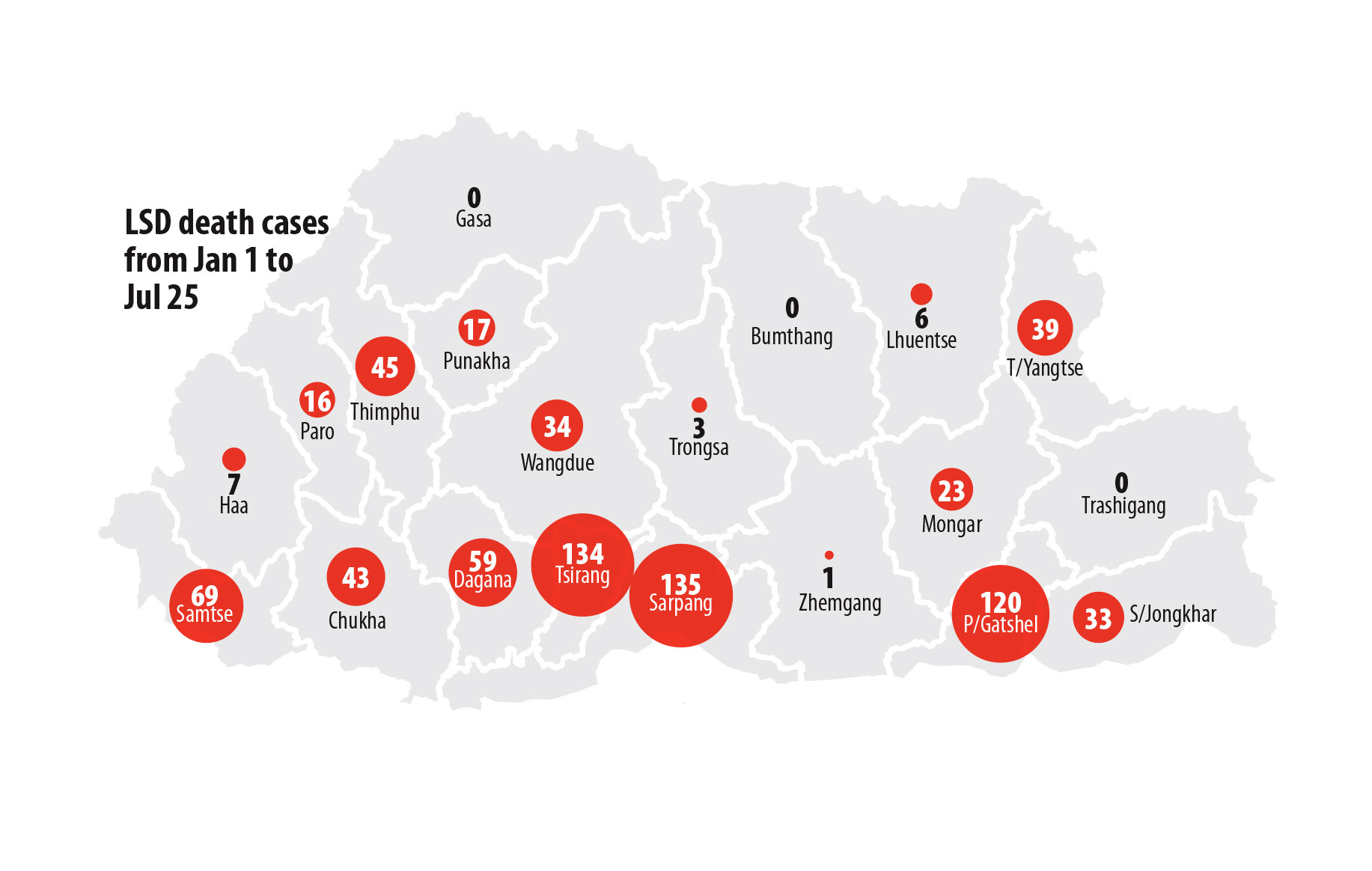YK Poudel
The outbreak of lumpy skin disease had affected at least 9,676 cattle and 784 have already died since its first outbreak in January this year.
Lumpy skin disease is a highly contagious viral disease that leads to the formation of nodules and wounds on the skin, resulting in severe health implications for cattle.
According to the latest data available from National Centre for Animal Health, Bumthang and Gasa are the only unaffected dzongkhags.
Due to the widespread infection in summer, which is an economic period for the farmers, the farmers have had to incur heavy losses in livestock and dairy production, among others.
Deputy chief veterinary officer of Mongar, Dr Narayan Pokhrel, said that the situation in the dzongkhag is serious. “Many new cases are coming up every day. Livestock officials are attending to all the cases and doing their best to provide timely treatment, wound management, hydration, and nutritional management.”
He said: “With only one livestock extension officer in the gewog, it is difficult to meet the farmers demands related with the disease.”
Dr Jamtsho, a veterinary doctor of Wangdue, said that the number of livestock getting infected is on the rise. “Thirteen out of 15 gewogs have reported livestock infection – over 600 cattle are infected, and 34 death have been reported to date.”
He said that the situation has worsened as the monsoon vector activities spread in summer. “Absence of specific treatment for the disease is causing livestock mortality greatly.”
According to him, acute shortage of livestock extension supervisors in most gewogs has further exacerbated the situation. “Seven out of 15 gewogs do not have livestock supervisors.”
Veterinarians say that the infected cattle will experience acute fever, salivation and discharge from eyes and nose, and blister-like nodules all over the body.
“Some animals could have died due to the vaccination at the time of infection. The infection of the virus and the strength of the vaccine could have weakened the cattle,” a veterinarian said.
Veterinarians say that farmers in the south of the country had to face a major loss as the outbreak of the disease happened during the planting season.
A senior veterinary officer, Pelden Wangchuk, said that to address the escalating situation, response measures have been implemented in accordance with the National LSD Prevention and Control Plan 2021.
He said: “These measures primarily focus on early detection and isolation of infected animals, symptomatic treatment of affected animals as there is no effective treatment currently developed for LSD, and imposing movement restrictions as long-distance spread of LSD is associated with the transport of live cattle.”
Advisories and notifications, he said, were consistently shared and programmes were organised to raise awareness on LSD prevention and control focusing on the need to improve farm biosecurity, farm management practices and immediate reporting to implement response measures.
Officiating Programme Director of NCAH, Dr Sangay Rinchen, said that due to monsoon, the risk was high. “However, with outbreak control measures implemented, the situation is under control. NCAH is managing the surge in medicine requirement through emergency procurement.”
He said: “Since the outbreak is not yet fully controlled, an impact assessment is yet to be done.”
Bhutan has been on high alert since July 23, 2020 when the Food and Agriculture Organization (FAO) country office warned of a potential threat of LSD introduction into the cattle population.
Lumpy Skin Disease, endemic to African and Middle Eastern countries, has rapidly made its way to Asian countries, with Bhutan confirming its first outbreak in Samtse on the October 5, 2020.
The LSD is not a disease of public health concern.
There is no treatment for the disease; it can be only cured through supportive therapy which reduces the intensity of the infection. Currently, the animals are being treated with antibiotics, analgesics, antihistamines, and multivitamins. There is also no vaccine against the virus.


